

SLHS: New Place



Disclaimer
Whilst some care has been taken to check externally linked websites no responsibility is offered nor implied for the suitability, legality or reliability of content therein.
Statements are made here to the best of our knowledge. However no statement here should be regarded as irrefutable fact. Please contact us if you consider otherwise.
History
The area’s name comes from the very checkered history of this corner of Stratford. There have been several complete new buildings on the site.
Originally Chapel Lane extended right down to the river (no theatre or canal basins had been built then). On its left-hand side, along its length, was a path through a pleasant green pasture.
At some stage, where Chapel Lane met the High Street at the top end, there may have been modest cottages on the site but in 1483 Hugh Clopton had the wealth to buy the whole strip and build himself the largest building in Stratford.
SLHS Picture & Document Archives
-
Present day: New Place Gardens
Located on the corner of Chapel Street and Chapel Lane
Last update: 31/10/2024
Further Information
-
Official website: New Place
-
Summary: Britain Express
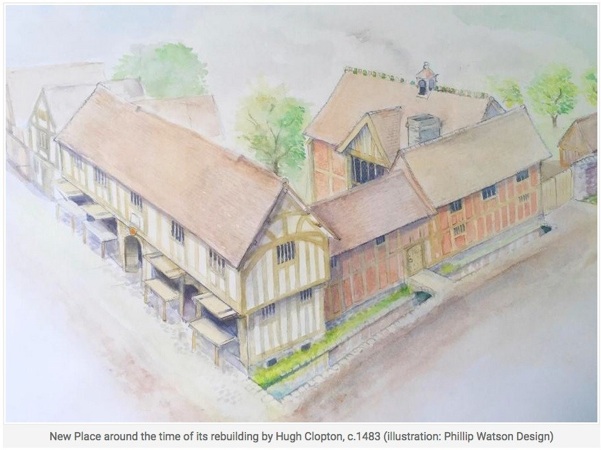
● These items have aspects that uniquely contribute to national or world history.
Not Just A Dwelling
Where the building fronted onto the High Street pavement awnings folded out which provided selling space for the town’s artisans which the wise merchant was once, a mercer, himself.
(For Clopton’s story use link above).
Shakespeare Retires Here
Shakespeare is one of only a handful of artists at the time who benefitted greatly from their skills during their own lifetime so 114 years after its building, in 1597, Shakespeare bought the whole place.
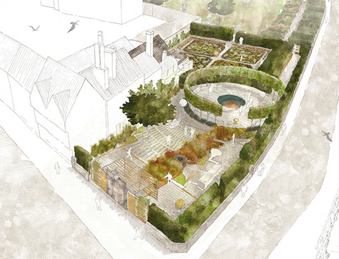
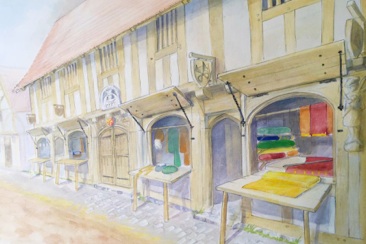
A Place Of Happiness
Shakespeare’s wife must have been very happy. Life expectancy is those days was not brilliant. There were five children but only two daughters survived to adulthood. He continued to write until his death at 52 in 1616. As was the norm then the house passed to his eldest daughter, Susanna, and only the main bed to the younger Judith (perhaps because of her poor choice of husband, Thomas Quiney a vintner, who married her without proper license and later had an illicit child with a Margaret Wheeler. All three of their children died). Susannah married Stratford’s only Doctor, John Hall. When she died in 1649 their daughter Elizabeth inherited it. In 1626 Elizabeth married Thomas Nash, Lord Of Shottery. He owned the house next door but sadly died without children. Two years after the death Elizabeth married again to John Barnard, MP for Northampton, where they made their home at Abingdon Manor.
The problem was that when Elizabeth (d 1670) and John died they’d had no children and so the house remained unoccupied and fell into a very poor state. John Clopton (Hugh’s great grandson) saw this and bought it.
A Completely New Place
As the whole concept of the building was mediaeval Clopton was never happy with it and so, in 1702, he demolished it and replaced it with a fantastic ‘modern’ building in keeping with his wealthy needs.
Whilst Clopton absolutely loved his lifestyle he never had an heir and so, when he died, the house was sold.

John Clopton’s fabulous new ‘modern’ house 1702
Down Again
The wealthy Gastrell family owned 18 properties in Stratford and now the house passed to Rev Francis Gastrell. It seems that democracy was eroding the benefits of large house ownership. The Lord’s of the Manor felt it an inhuman imposition to have their finances looked at and so riches were judged by the size of the family’s property. An easy measure was to count up the number of windows and so in 1696 a Window Tax was introduced. You can imagine that some owners bricked up windows to avoid paying it.
Gastrell was incensed and argued incessantly with the town corporation. With mounting back taxes due in 1759 he demolished the whole place -piling the rubble into the cellar and it became a permanent eyesore and embarrassment to all involved.
This is now all that’s left: the family well and beautiful gardens.
(For a map and tour of the present day gardens see SLHS Picture Archive below top half on right)
More of Elizabeth and Thomas Nash to go here.
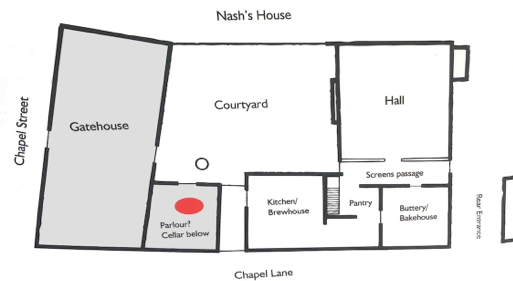
Shakespeare’s full facilities included fields for grazing livestock and his own beer making facilities 1597 SBT
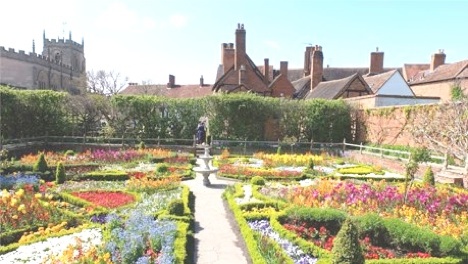
In 2010 the plan by SBT to extend visitor facilities would mean reworking the site. This was seen as a good opportunity to literally probe more deeply into the site’s history. Staffordshire University were commissioned with a 2 year planned excavation costing £5.25M.
-
Excavation 2014: Rear Of Nash’s House
-
This revealed surprisingly fragile remnants of previous modern buildings but underneath were foundations showing that the house extended further than thought.
-
Excavation 2015: Main Area Of New Place
-
Searching for remnants of the 1597 dwelling proved:
-
•there were more than 20 rooms with 10 fireplaces
-
•there was a great chamber
-
•thus it was the largest single dwelling in the town at that time
-
•there was a brewhouse
-
•many fragments of cookware, plates, cups etc
Further Information
-
Video of discussion of dig (YouTube 10m40): Warwick University interviews Paul Edmonson SBT
-
Detailed views of artifacts found in archaeological dig in 2005: Staffordshire Uni -Searching For Shakespeare
-

SLHS Picture & Document Archives -Archaeological Dig
-
Pictures not easily found: Dig 2015

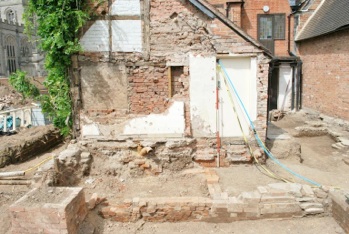
Archaeological Digs
Nash’s house: Rear
New Place: Below
Modern Era
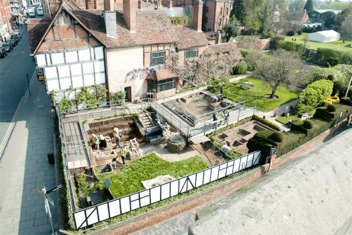
See the lower half of the Further Information box below.
New Place Archaeological Dig
New Place
Archaeological Dig

-
● Full
-
● Partial
-
● None
-
Theatres ●
To return to Master page click on ‘Shakespeare’ above.
